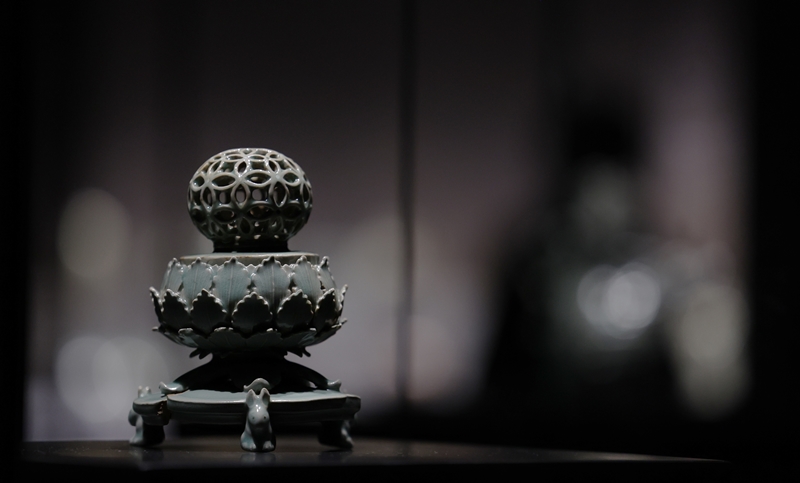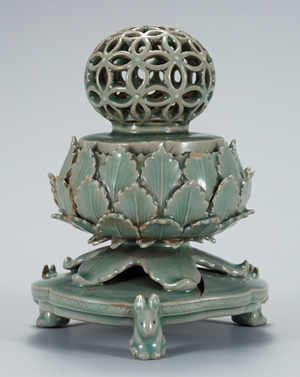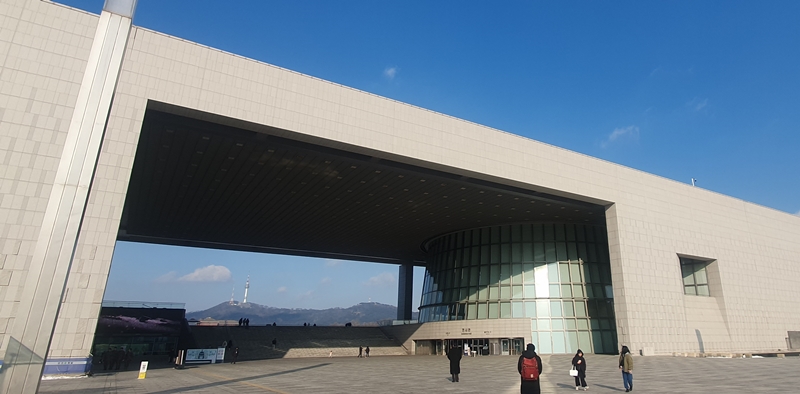박물관은 한 나라의 역사와 문화가 살아 숨 쉬고 과거와 현재, 미래가 공존하는 공간이다. 또한 그 나라의 문화의 힘을 확인할 수 있는 장소이기도 하다. 코리아넷이 대한민국의 지역별 국립박물관 6곳을 선정, 그곳에서 놓쳐선 안될 대표 소장품을 소개한다. 첫 번째 순서로 대한민국을 대표하는 박물관이자 가장 오래된 역사를 자랑하는 국립중앙박물관으로 가본다.
A museum is where a country's history and culture live and breathe and the past, present, and future coexist, as well as showing the nation's cultural power. Korea.net has selected six national museums by region to introduce leading must-see works displayed at each. The first is the National Museum of Korea, the country's leading and oldest facility of its kind.

▲ '청자 투각 칠보무늬 향로'는 고려청자의 화려함과 우아함을 대표하는 작품으로 1962년 국보로 지정됐다. Celadon Incense Burner with Openwork was designated a National Treasure in 1962 as an artwork representing fanciness and elegance. (Lee Jun Young - 이준영 기자 coc7991@korea.kr)
3. 고려 비색의 아름다움, ‘청자 투각 칠보무늬 향로’ - Celadon Incense Burner with Openwork: pale green glaze

▲ 전체 높이 15.3cm, 지름 11.5cm 크기의 아담한 향로이지만 고려시대의 우수한 공예 문화를 확인할 수 있는 대표작으로 손꼽힌다. Celadon Incense Burner with Openwork is small at 15.3 cm tall and a diameter of 11.5 cm but remains a leading work illustrating the outstanding handicraft culture of the Goryeo Dynasty. (National Museum of Korea - 국립중앙박물관)
박물관 3층 청자실 내 ‘고려비색’이라 이름 붙은 공간. 조도를 낮춘 전시실 곳곳에서 푸른 빛이 맴도는 가운데, 정중앙에서 반짝이는 작품이 있다. 고려 때 만들어진 '청자 투각 칠보무늬 향로'다.
The space Goryeo Celadon Color at the Celadon Gallery is on the third floor of the National Museum of Korea. Among ceramics that emit the color blue at the darkly lit exhibition hall is a sparkling one in the middle: Celadon Incense Burner with Openwork from the Goryeo Dynasty (918-1392).
향이 빠져나가는 뚜껑, 향을 태우는 몸통, 그리고 이를 지탱하는 받침까지 크게 세 부분으로 이루어져 있다. 뚜껑에는 칠보무늬가 투각(재료를 완전히 뚫거나 도려내 표현하는 조각 기법)돼 있고, 몸체는 꽃잎을 하나하나 붙인 활짝 핀 연꽃 모양을 하고 있다.
The three main parts are the lid, which emits the fragrance; the body, where the incense is burned; and the base, which supports it. The lid sports an openwork cloisonne pattern (a carving technique that completely pierces or cuts out the material) and the body's shape is that of a lotus flower with petals attached one by one.
백미는 뭐니 뭐니 해도 향로를 등에 지고 있는 세 마리의 토끼다. 귀를 쫑긋 세운 채 웅크리고 있는 토끼의 모습이 섬세하게 묘사돼 있다. 눈동자까지 까만 철 안료로 찍어 표현함으로써 생동감을 불어넣었다.
The highlight of the work is the three rabbits at the bottom carrying the burner on their backs, showing them crouching down with their ears pricked up delicately shown. Even the pupils in their eyes were painted with a black iron pigment to make them lifelike.
향로에는 음각, 양각, 투각, 상감, 철화 등 다양한 기법이 활용됐다. 서유리 국립중앙박물관 미술부 학예연구사는 "고려청자 장인이 구사할 수 있는 모든 기법이 동원된 기술의 결정체"라며 "여기에 고려청자만의 아름다운 비색, 다시 말해 특유의 밝고 투명한 푸른색의 유약이 씌워져 아름다움을 자아낸다"고 설명한다.
Several techniques went into making the burner such as engraving, embossing, openwork, inlay, and iron painting. "The incense burner epitomized all the techniques available to a Goryeo celadon artisan," said Seo Yuri, an art curator at the museum. "And here, the distinctive color of Goryeo celadon, or in other words its unique bright and transparent blue glaze, creates beauty."
한국의 시인이자 소설가인 박종화는 그의 시 ‘청자부’에서 고려청자를 “가을 소나기 마악 지나간 구멍 뚫린 가을 하늘 한 조각”이라 노래했다. 또 미술사학자 고유섭은 “청자는 고려인의 파란 꽃”이라 말한 바 있다. 박물관을 방문한다면 한국의 하늘색과 닮은 청자의 아름다움을 한껏 감상할 수 있는 기회를 놓치지 말 것.
In his poem "Cheongjabu," poet-novelist Park Jong-hwa (1901-81) called Goryeo celadon "a piece of an autumn sky through which fall rain showers pierced a hole." Art historian Ko Yu-seop (1905-44) described celadon as "the blue flower of the Goryeo people." Thus a visit to the nation's leading and oldest museum is simply incomplete without seeing the beauty of Goryeo celadon reminiscent of a Korean sky.
4. 사람을 매료시키는 단순함의 미학 ‘백자 달항아리’ - Captivating aesthetics of simplicity: White Porcelain Moon Jar

3층 분청사기∙백자실에는 '백자 달항아리'만을 감상할 수 있는 자그마한 공간이 있다. 눈 내리는 배경 영상과 함께 전시된 백자 맞은편에 마련돼 있는 두 개의 의자. 관람객들은 그곳에 앉아 한참 동안 '달멍'의 시간을 가진다.
The Buncheong Ware and White Porcelain Gallery on the museum's third floor has a small space displaying the White Porcelain Moon Jar. Two chairs opposite the work with a video of falling snow in the background allow visitors to observe the porcelain for a while.
17세기 말에서 18세기 전반 사이에 제작된 것으로 추측되는 달항아리는 그 모습이 크고 둥근 보름달을 닮아 있다. 일제강점기에는 둥근 항아리라 하여 '원호'(圓壺)라 불리다가 한국미학의 선구자라 불리는 고유섭과 화가 김환기에 의해 '달항아리'라는 새로운 이름을 얻게 됐다.
Believed to have been made between the late 17th and the early 18th century, the big and round jar resembles a full moon and was called wonho (round jar) during Japanese colonial rule of the Korean Peninsula (1910-45). It was renamed "moon jar" by art historian Ko, a pioneer of Korean art, and artist Kim Whanki (1913-74).
이렇게 큰 항아리는 한번에 빚어내기 힘들어 반원형의 몸체를 위아래로 이어 붙여 만들기 때문에 가운데에 접합 흔적이 남아있다. 둥글면서도 좌우 대칭이 살짝 어긋나 이지러진 모습을 보이는데, 이러한 특징이 실제 달과 같은 자연스러운 아름다움으로 다가온다. 섬세하거나 화려한 무늬는 없지만 온화한 백색과 유려한 곡선은 마음을 편하게 해준다.
A jar of this size is difficult to make in one attempt, so it has a trace in the middle of joining the semicircular body with the top and bottom. Though round, its shape is slightly asymmetrical between left and right for an uneven appearance, but this gives it a natural beauty like the moon. The work lacks delicate or fancy designs and its gentle white and elegant flowing curves are said to soothe the mind.
임진아 국립중앙박물관 미술부 학예연구사는 “달항아리는 300년 전에 만들어졌지만 현대적인 감각을 갖춘 작품”이라며 “밝고 따뜻한 느낌이 감도는 백색 바탕에 인위적이지 않고 자연스러운 형태는 기능을 가지고 사용된 그릇이라기보다는 하나의 오브제에 가깝다”고 설명한다.
"White Porcelain Moon Jar was made 300 years ago but has a contemporary sense," another art curator of the museum Im Jin A said. "Its white background gives a bright and warm feeling and its unartificial and natural shape makes it closer to an object rather than a functional jar."
출구 쪽에는 '손으로 보는 달항아리'라는 촉각체험 코너가 마련돼 있다. 달항아리 겉면을 손으로 만져볼 수 있는데 그 매끈함과 부드러움을 직접 느껴볼 수 있다.
The gallery exit features a tactile corner where visitors can touch the jar's surface and feel its sleek and soft texture.

▲ 서울 용산구에 위치한 국립중앙박물관 전경. This is an exterior view of the National Museum of Korea in Seoul's Yongsan-gu District. (Lee Kyoung Mi - 이경미 기자 km137426@korea.kr)
# 국립중앙박물관 즐기기 (下) - Enjoying National Museum of Korea (II)
- 넓디 넓은 박물관 전체를 한 번에 다 보려 하다가는 후들거리는 다리를 붙잡아야 할 수도 있다. 푹신한 소파, 벤치, 카페 등 다양한 형태의 휴게 공간이 박물관 곳곳에 마련돼 있으니 천천히 쉬어 가며 관람하기를 추천한다.
- Trying to see everything at the massive museum could prove physically exhausting. So taking it slow and going on occasional breaks throughout the museum on soft couches and benches and at cafes are recommended.
- 국립중앙박물관은 사진 맛집이기도 하다. 화창한 날에는 박물관 건물 사이로 보이는 파란 하늘과 하얀 구름, 멀리 보이는 남산서울타워가 함께 걸리는 멋진 사진을 남길 수 있다. 박물관에 들어가기 전, 또는 박물관을 나와서 꼭 찍어 보길. 초보자도 인생샷이 가능하다.
- The National Museum of Korea is a great place for photo opps. On a sunny day, take snaps of the blue sky and white clouds and N (Namsan) Seoul Tower in the distance, both of which are visible between the museum's buildings. Taking photos before entering and after leaving the museum is highly recommended, as even novices can take great shots.
"Read more of the article 국립중앙박물관 - National Museum of Korea (Part I) here."
서울 = 이경미 기자 km137426@korea.kr
By Lee Kyoung Mi, km137426@korea.kr



.jpg)





0 comments: